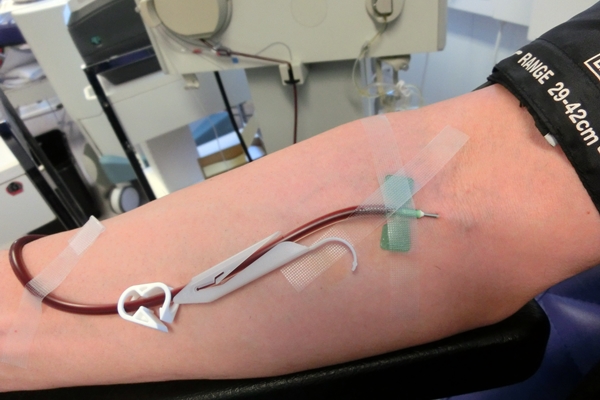6 November 2017. Results from a small-scale clinical trial indicate treatments with plasma infusions from young donors are safe for patients and may improve functional abilities. The findings were presented on 4 November by Stanford University neurology professor Sharon Sha at the Clinical Trial on Alzheimer’s Disease conference in Boston.
Sha’s team at Stanford tested a hypothesis by fellow Stanford neurologist Tony Wyss-Coray that regenerative abilities of the brain, diminished in the aging process, can be renewed by blood plasma from younger individuals. These infusions, says Wyss-Coray, can activate signaling pathways for a number of tissues, including regions of the brain affecting memory and thought. Earlier tests of the hypothesis with mice suggest repeated infusions of blood plasma from younger animals can improve memory functions in older recipients.
The early-stage clinical trial tested the safety of these treatments among a small sample of individuals at Stanford University Medical Center. The study recruited 18 patients diagnosed with mild to moderate Alzheimer’s disease, divided into 2 groups of 9 participants. The first group of participants were assigned to receive donations from people age 18 to 30 of their plasma, the liquid part of blood without blood cells, or a placebo once a week for 4 weeks. After a 6-week period to allow effects of the plasma to wash out, the treatments were reversed, so original placebo recipients received 4 weekly doses of plasma, and plasma recipients received the placebo.
The study team discovered the travel burden on participants of the infusions, as well as initial and final evaluations, was becoming difficult to sustain, so the researchers changed the procedure for the second group of participants, providing all 9 individuals with 4 weekly plasma donations. The study’s main objective was to detect any adverse effects on participants, but individuals in the study also received a number of tests of their functional abilities, cognition, and depression.
The safety results showed few adverse effects, with repeated itching being the most common complaint of participants. Sha says this is a common and not unexpected allergic response to transfusions of blood products. One participant, a placebo recipient in the first group, suffered a stroke, but because it occurred at the end of the 6-week period between treatments, the stroke was not believed to be a result of the treatments.
Sha’s team reports that recipients of the plasma showed statistically reliable improvements in 2 of the 3 functional ability tests, compared to placebo recipients, with most of the gains occurring among the first group of 9 participants in the blinded treatment-versus-placebo part of the study. On tests of cognition and depression, however, no differences were found between the treatment and placebo groups.
Wyss-Coray is a founder of Alkahest Inc., a spin-off enterprise from Stanford that licenses his research and is developing plasma-based therapies for neurodegenerative diseases. The company, which sponsored the trial, says the overall safety and even limited results showing functional improvements provide enough evidence to advance a plasma treatment for Alzheimer’s disease.
More from Science & Enterprise:
- Report – 126 Alzheimer’s Drugs in Clinical Trials
- First Trial of Alzheimer’s Drug Underway
- Trial Underway Testing Alzheimer’s-Schizophrenia Drug
- Computer-Designed Antibodies Target Alzheimer’s Proteins
- LEDs Shown to Reduce Alzheimer’s Brain Plaques
* * *


 RSS - Posts
RSS - Posts
[…] Plasma Infusions to Treat Alzheimer’s Shown Safe […]